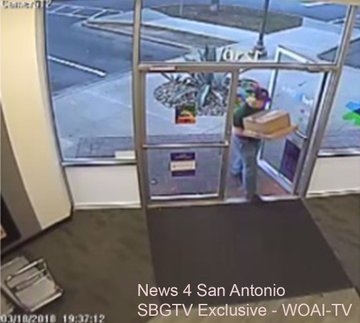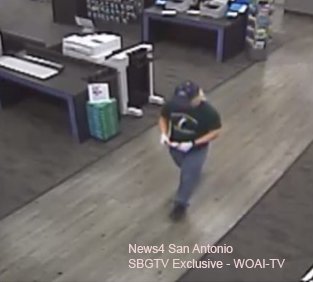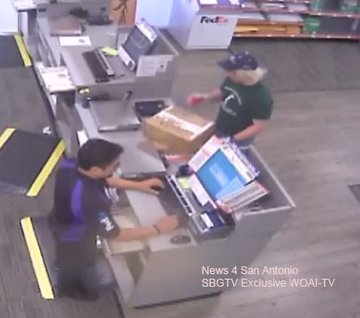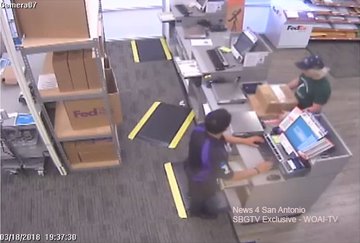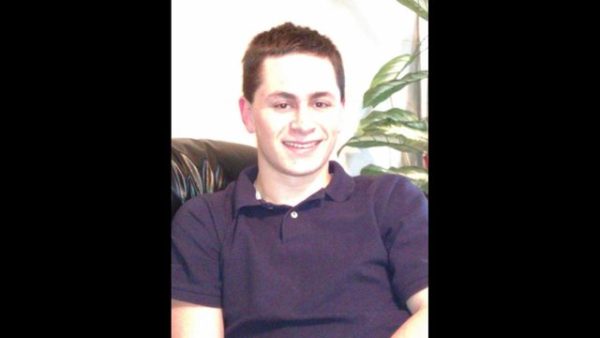


“The suspect is deceased and has significant injuries from a blast that occurred from detonating a bomb inside his vehicle,” Austin Police Chief Brian Manley told journalists near the location where the suspected package bomber died in Round Rock, Texas, in suburban Austin on Wednesday.
Scott Olson/Getty Images
Updated at 10 a.m. ET
A man whom police had identified as their top suspect in a string of deadly bombings in the Austin, Texas, area this month killed himself early Wednesday by triggering an explosion in his car as officers approached the vehicle to make an arrest, police said Wednesday.
The dead suspect is Mark Anthony Conditt, a federal law enforcement source has confirmed to member station KUT.
Earlier today, police identified the suspect only as a 24-year-old white male. It now seems there are questions about his age — records suggest Conditt was 23 when he died. Austin Police Chief Brian Manley said he would await positive identification and notification of next of kin before making an official announcement.
The suspect died in the Round Rock community of Greater Austin, north of where the first bomb struck on March 2.
“Beginning within the past 24-36 hours we began to get information of one person of interest that moved to a suspect,” Manley told reporters, standing in the early morning darkness along I-35. He spoke near the spot where the suspect, believed to be responsible for two deaths and several injuries, had died hours earlier.
“Late last night and this morning we felt very comfortable that he was the suspect,” Manley said. He said the man had been identified with the help of leads from “video sources, as well as by witnesses.”
Manley would not say where the suspect is from, or where he lived. But local media are converging on a residential area of Pflugerville, less than 10 miles southeast of where the suspect died. At least two different reporters are citing a large law enforcement presence there and warnings to stay back.
The suspect had been traced to a hotel parking lot in Round Rock after the vehicle he was known to be driving was located. Police and federal agents soon swarmed around the hotel — where they waited for tactical backup, in the form of armored vehicles that might help them take the suspected bomber into custody “as safely as possible,” Manley told reporters.
“While we were waiting for those vehicles to get here, much time had passed, and the vehicle started to drive away,” Manley said. “We began following the vehicle, again waiting to get the tactical vehicles here so we could make a stop.”
That’s when the suspect’s vehicle stopped in a ditch on the side of the busy road.
“As members of the Austin Police Department SWAT team approached the vehicle, the suspect detonated a bomb inside the vehicle, knocking one of our SWAT officers back. And one of our SWAT officers fired at the suspect, as well. The suspect is deceased and has significant injuries from a blast that occurred from detonating a bomb inside his vehicle.”
“This is the culmination of three very long weeks for our community,” Manley said in reference to the first bomb on March 2 and six others that followed.
Manley also warned that the public should remain vigilant and cautious, in case the bomber had been able to deploy any final explosive devices because, as he said, “we don’t know where this subject has spent his last 24 hours.”
Manley said the suspect’s name had come up during the investigation and that “we became very interested in him over the past couple of days.” Police are still not sure why the man would have become a serial bomber.
“That’s the one thing we don’t have right now, is a motive behind this. We do not understand what motivated him to do what he did.”
Austin Mayor Steve Adler says he was contacted and kept updated as the events were unfolding.
“It’s been an absolute relief” to have a potential end to the case, Adler said. “As these incidents have been occurring with increasing frequency, the anxiety and fear in the community has been growing. So it was good to be closing in over the last day or so — and to have this resolution.”
President Trump welcomed the news, saying in a tweet, “AUSTIN BOMBING SUSPECT IS DEAD. Great job by law enforcement and all concerned! ”
The confrontation early Wednesday came after police dealt with two more package bombs found on Tuesday at separate FedEx facilities near San Antonio and the one in Southwest Austin. They are the latest of six such devices this month that the FBI and other agencies say are connected.
An explosion that was reported at a Goodwill store in south Austin initially caused alarm that it may have been related, but as member station KUT reports, “Austin Assistant Chief of Police Ely Reyes said the device was an ‘artillery simulator’ – an old military memento. He said it was not related to the serial bombings.”
Citing an unnamed high-ranking law enforcement official, The Austin Statesmanreports that police used security video from a FedEx store in Southwest Austin where a bomb had been shipped earlier to identify the suspect.
The newspaper says authorities used “store receipts showing suspicious transactions from the person and obtained a search warrant for his Google search history that showed him conducting searches they considered suspicious.”

Law enforcement officials put on protective gear as they investigate in the area where the suspected package bomber died in an explosion in suburban Austin early Wednesday in Round Rock, Texas.
Scott Olson/Getty Images
The suspect died roughly 24 hours after a nighttime blast on Tuesday, when a package detonated at a FedEx Ground facility in Schertz, Texas, northeast of San Antonio. One person was treated and released in that package bomb incident.
“It was mailed from Austin, and it was mailed back to Austin” going through the FedEx center in Schertz, state Attorney General Ken Paxton told KXAN-TV news.
The package had been addressed to an Austin resident, Paxton said.
A second, unexploded package was found hours later on Tuesday, at another FedEx facility. It had apparently been shipped by the same person.
In a statement late Tuesday, the Austin Police Department, the FBI and the Bureau of Alcohol, Tobacco, Firearms and Explosives said:
“[At] approximately 6:19 a.m., APD received a call regarding a suspicious package at 4117 McKinney Falls Parkway in Austin. APD, along with the FBI and the ATF, responded. It was determined the package contained an explosive device and was disrupted by law enforcement. No injuries were reported.”
Officials believed the package that exploded may have come from an address on Brodie Lane that houses a FedEx Office printing and shipping office, part of the large Sunset Valley Shopping Center, southwest of downtown Austin, the Sunset Valley Police Department said.
U.S. Rep. Michael McCaul, a Republican from Austin who is chairman of the House Homeland Security Committee, told The Associated Press that investigators had been poring through surveillance videos. “They’ve got a couple of videos that could possibly be the person but they’re not sure at this point,” McCaul said.
“There is an army of law enforcement folks that are here,” Austin Mayor Steve Adler told NPR’s David Greene about the effort to end the bombing threat. “Hundreds of federal agents, multiple federal agencies, hundreds of agents working on this outside of Austin and Texas.”
The investigation into the Schertz blast was slowed by the need to ensure the FedEx facility was safe, FBI Assistant Special Agent in Charge James Smith said at a midmorning update. Many of those same concerns played into the delay in approaching the suspect Tuesday night.
A blast along a sidewalk on Sunday had been triggered by a tripwire — indicating that the culprit was likely more sophisticated than investigators had first realized.
One day later, police said they believed the bombings were all connected and said they believed they were dealing with a “serial bomber.”
Austin Police Chief Brian Manley said the conclusion comes from “some of the specific components of these devices.”
“We are sending all of the evidence to the ATF lab in Quantico, and they are conducting all of the post-blast analysis of the evidence that we have recovered,” Manley said.
The bombing scare has set Austin on edge for weeks now. Adler also said that he realized something through visiting communities during the ordeal:
“We don’t know the neighbors around us as well as we should. And my hope is that one of the legacies of this moment is that we all walk across the street — or down the street or across the hall — and get to know the people around us in ways we don’t now.”
This is a breaking news story. As often happens in situations like these, some information reported early may turn out to be inaccurate. We’ll move quickly to correct the record and we’ll only point to the best information we have at the time.
Source: NPR
more recommended stories
 Fentanyl Seizures at Border Continue to Spike, Making San Diego a National Epicenter for Fentanyl Trafficking
Fentanyl Seizures at Border Continue to Spike, Making San Diego a National Epicenter for Fentanyl TraffickingFentanyl Seizures at Border Continue to.
 Utah Man Sentenced for Hate Crime Attack of Three Men
Utah Man Sentenced for Hate Crime Attack of Three MenTuesday, August 8, 2023 A.
 Green Energy Company Biden Hosted At White House Files For Bankruptcy
Green Energy Company Biden Hosted At White House Files For BankruptcyAug 7 (Reuters) – Electric-vehicle parts.
 Former ABC News Reporter Who “Debunked” Pizzagate Pleads Guilty of Possessing Child pδrn
Former ABC News Reporter Who “Debunked” Pizzagate Pleads Guilty of Possessing Child pδrnFriday, July 21, 2023 A former.
 Six Harvard Medical School and an Arkansas mortuary Charged With Trafficking In Stolen Human Remains
Six Harvard Medical School and an Arkansas mortuary Charged With Trafficking In Stolen Human RemainsSCRANTON – The United States.
 Over 300 People Facing Federal Charges For Crimes Committed During Nationwide Demonstrations
Over 300 People Facing Federal Charges For Crimes Committed During Nationwide DemonstrationsThe Department of Justice announced that.


